Family : Scorpaenidae

Text © Giuseppe Mazza

English translation by Mario Beltramini
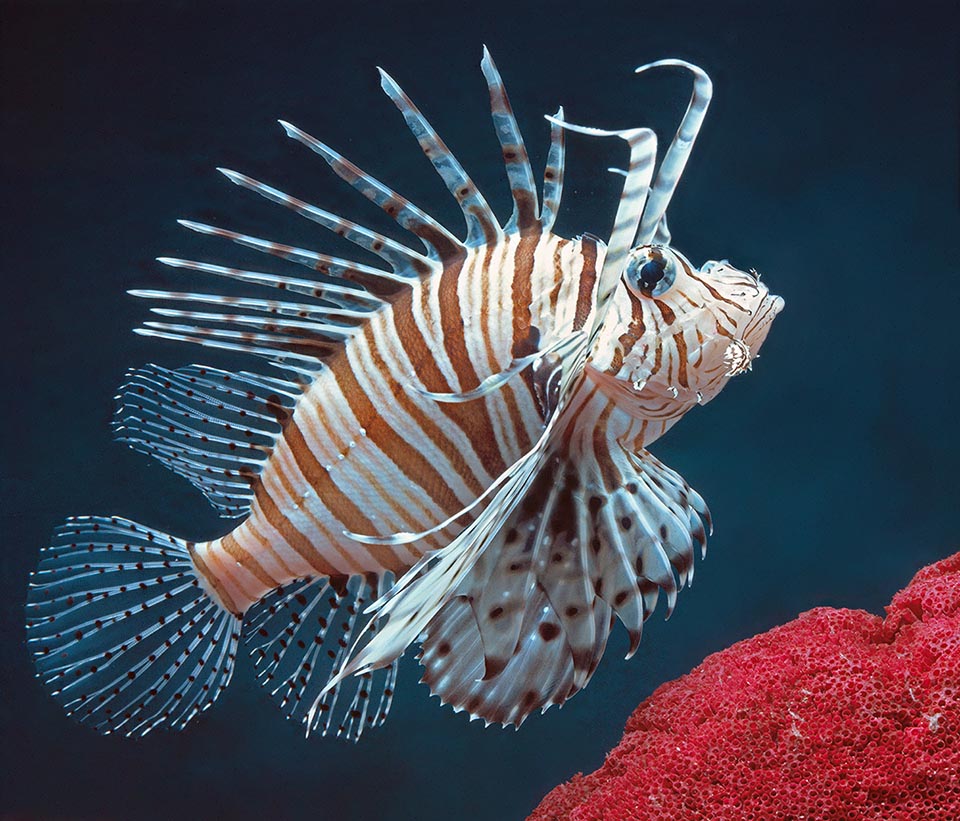
Known as Scorpionfish or Cobra fish due to the venemous spines, Pterois volitans lives in the tropical waters of eastern Indian Ocean and of Pacific © Giuseppe Mazza
Called at. times Scorpionfish or Cobra fish due to its venemous spines, but also Lionfish due to the thick mane of fins, Pterois volitans (Linnaeus, 1758) belongs to the class of the Actinopterygii, the ray finned fishes, to the order Scorpaeniformes and to the family of the Scorpaenidae, the same as the dreadful Stonefish (Synanceia verrucosa) and the Red scorpion fish (Scorpaena scrofa).
The name of the genus Pterois originates from the Greek “pteron”, wing, quill, with reference to the splendid fins, similar to feathers, whilst the specific term volitans, flying in Latin, refers to its majestic and whirling way of moving.
Zoogeography
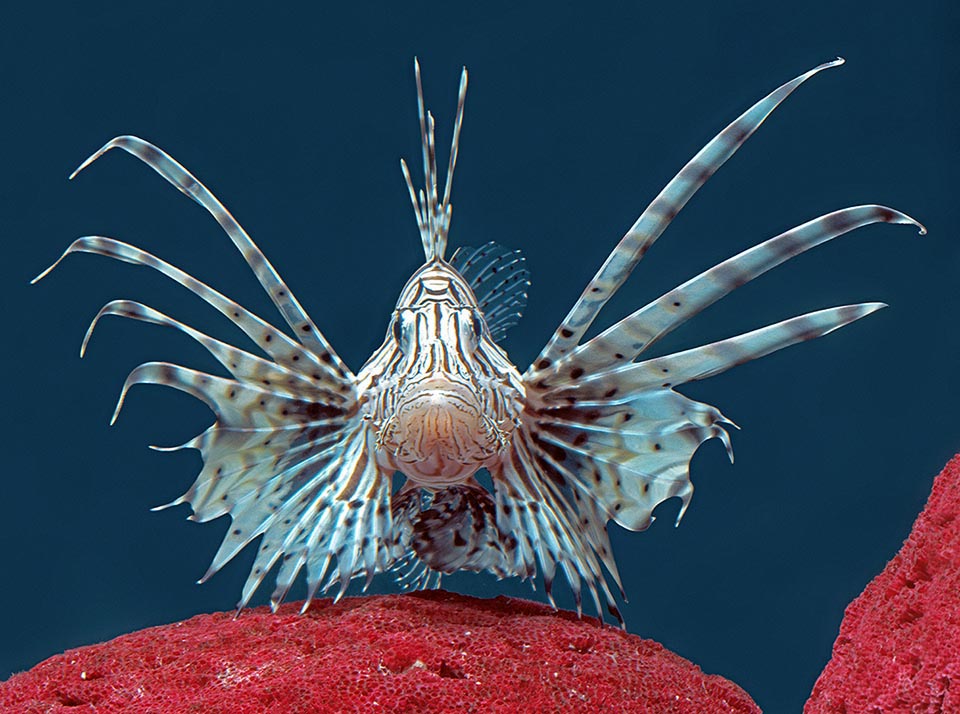
It’s also called Red Lionfish for the thick mane of fins, and uses the giant pectorals to terrorize the prey and push them in a corner © Giuseppe Mazza
It lives in the tropical waters of the eastern Indian Ocean and of the Pacific.
Indicatively, we find it in Mauritius, Cocos Islands, India, Thailand, Australia, Indonesia, Micronesia, New Guinea, New Caledonia, Philippines, Taiwan and China up to southern Japan. Eastwards, it has colonized Samoa, Tonga and Marquesas Islands. Southwards, it reaches Lord Howe Island.
But nowadays its distribution does not stop here as it has been introduced by man in Florida after the breaking of an aquarium, in August 1992, due to the damages caused by the hurricane Andrei or, maybe, by some irresponsible aquarist who has freed them in the sea.
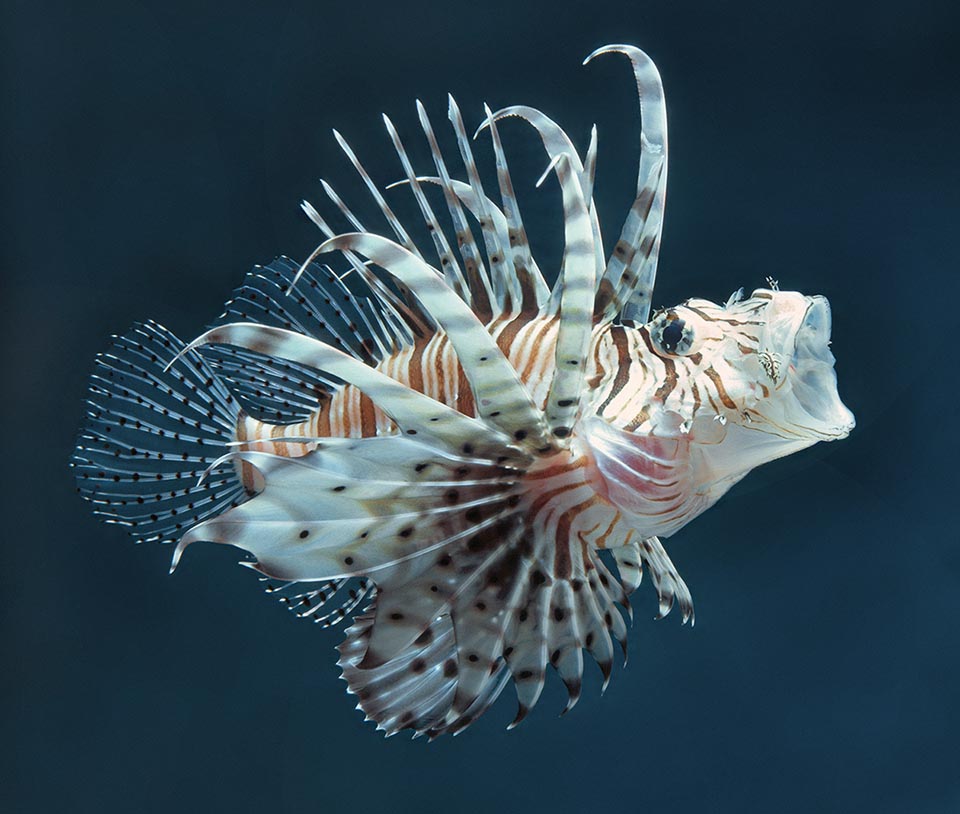
Then it opens wide the big protractile mouth and sucks them up holding them, when big, with its tiny teeth © Giuseppe Mazza
What is sure is that in 1995 it was present off Dania Beach in Florida, in 2000 it had reached the Carolina and the Bermuda, in 2004 the Bahamas, then in 2007 Cuba and in 2008 the Cayman Islands, the islands of Hispaniola, Jamaica, Puerto Rico and Colombia, in 2009 Mexico, Panama, Costa Rica and Venezuela: shortly, the whole Gulf of Mexico. And the colonization goes on in South America thanks to the currents that transport the planktonic larvae.
In the Caribbean it has caused serious damage to the fauna because it has no foes, apart some shark, who however ignores them as having not yet learnt to consider them as prey, and the big groupers that are in marked decline with the other local predators because the voracity of the Scorpionfish deprives them their nourishment.
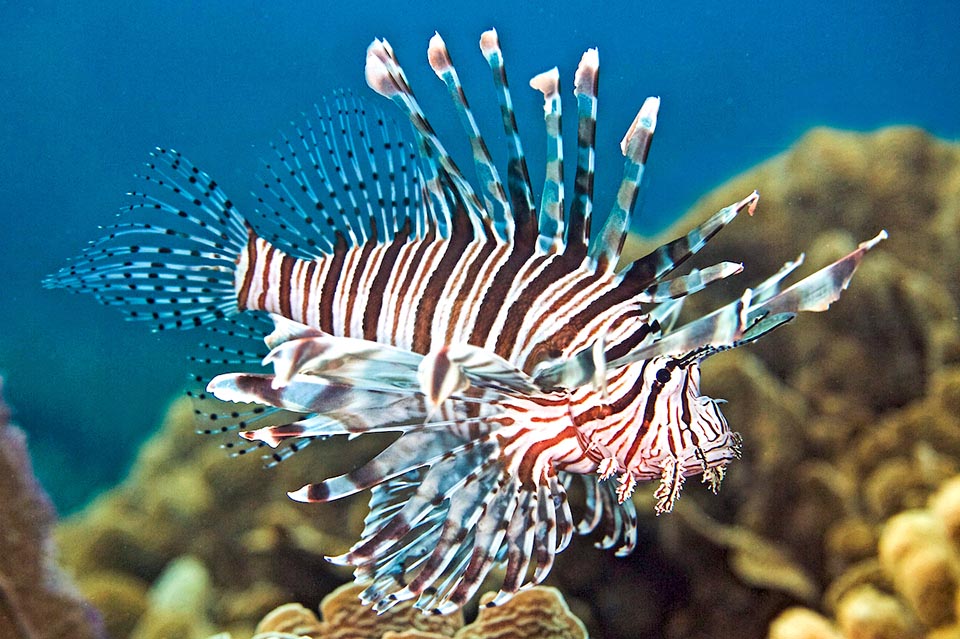
It hunts mostly in the twilight and night hours, spending lazily the day in a den, and uses its strong venom only for defense. With the 13 hollow spiny rays of the back, connected to venom glands, strikes head-on the importunates, and with the anal 3 plus the 2 of the pelvic fins, faces any attacks from below © Allison & Carlos Estape
Ecology-Habitat
Pterois volitans goes down up to 50 m of depth among the madreporic formations rich in hideouts, but is found also in rocky environments and in harbours. It does not love the currents but the calm waters where it may twirl without any effort. It chooses a den, at times to rest even upside down during the day, and is aggressive towards the intruders of other species.
Morphophysiology
It can reach the length of 38 cm. Excluding the fins, the body structure is that of the Red scorpion fish: fusiform body and big head.
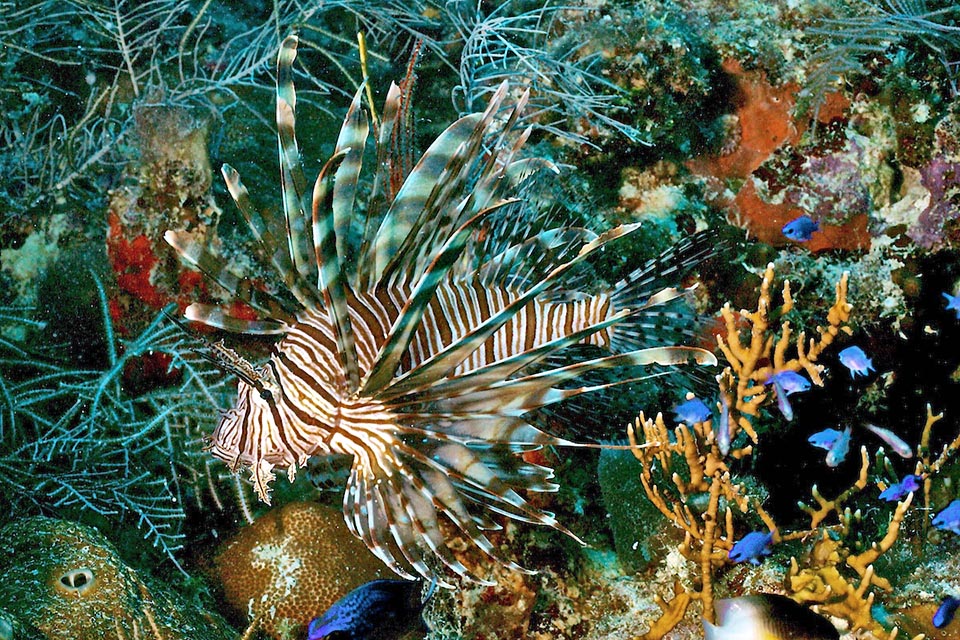
It has no natural foes in the Caribbean. The sharks have not yet memorized it among prey and the big predators like groupers are decreasing due its voracious competition © Allison & Carlos Estape
The colouration may change depending on the zone. Usually, it has a clear livery with vertical bands and reddish spots, but the populations living along the rocky coasts and the estuaries can even be almost black.
Also the shape of the showy pectoral fins can change slightly, but, like in the similar Pterois miles, present in the Red Sea and in the Indian Ocean, with trespasses in the eastern Mediterranean through the Suez Canal, these are always merged at the base and often displays a large tentacle over the eyes.
These are two species identical at first glance, determinable only by molecular examination or in base to the range usually not overlapped.
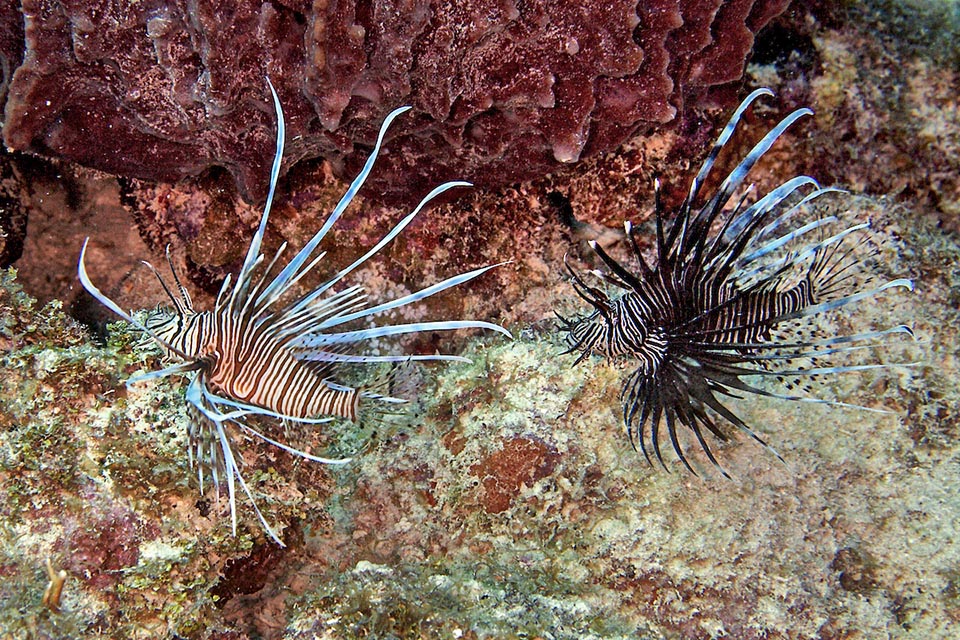
Pterois volitans shape and colour are quite variable. Along the rocky coasts and the estuaries it is not rare to meet even almost black specimens © Allison & Carlos Estape
Morphologically, if we have the specimen in hand, paying attention to the venemous spines, Pterois volitans has a few rays more than Pterois miles: 9-22 versus 9-11 in the soft ones of the dorsal fin, 6-8 vs. 6-7 in the anal and 14-16 vs. 13-15 in the pectoral ones.
The adults of Pterois miles should have on the other hand a band of small spines along the cheek.
In the Caribbean, where recently also Pterois miles, has been found, clearly in minority in the findings, were born some hybrids more vigorous than their parents (heterosis) and some scholars think that this may have contributed to their invasiveness.
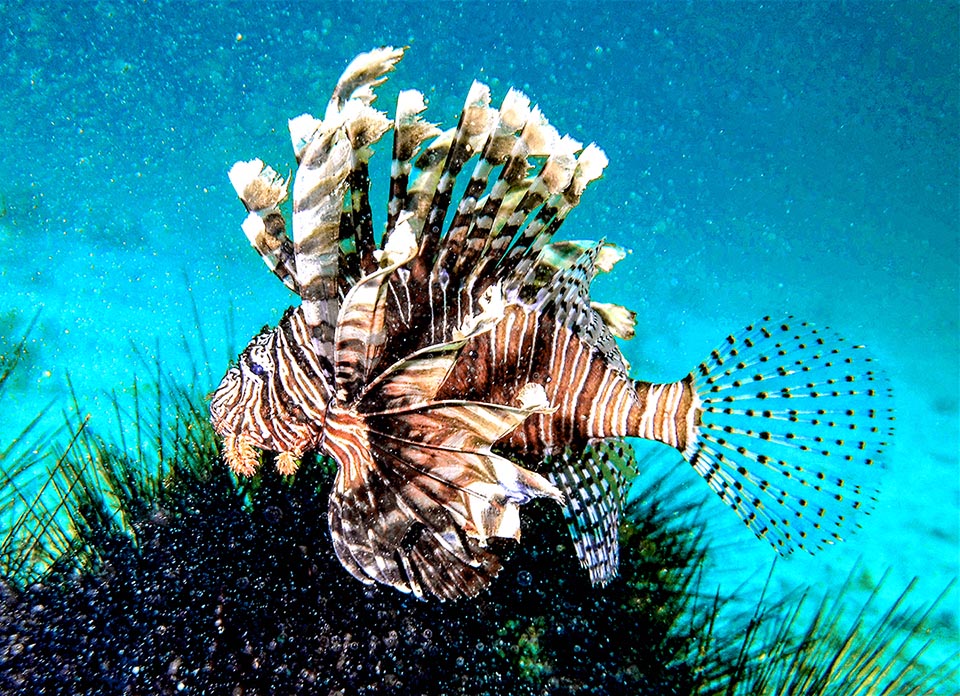
Majestic specimen. The Scorpionfish can reach 45 cm and 1,4 kg. The flesh, very prized, often appears in the local restaurants © Karine Marangon
About the poison, Pterois volitans on the dorsal has 13 spiny hollow rays connected to respective venom glands, 3 hollow spiny rays on the anal, and 1 on each pelvic fin, whilst the spectacular pectoral ones are unarmed like the rounded caudal.
They do not use the poison for huntings, which remains a defensive weapon, but opening their huge mouth wide they suck up the prey that is then held by tiny teeth.When they feel threatened, if they cannot get away, they violently attack the importunate, divers included, hitting them with their venemous rays of the dorsal, active even after the death of the fish.
The poisonings, apart from the intense pain and swellings or local necrosis with loss of sensitivity for several days, cause in humans nausea, vomiting, dizziness, fainting, breathing difficulty, drop in blood pressure, convulsions and even cardiac arrest.
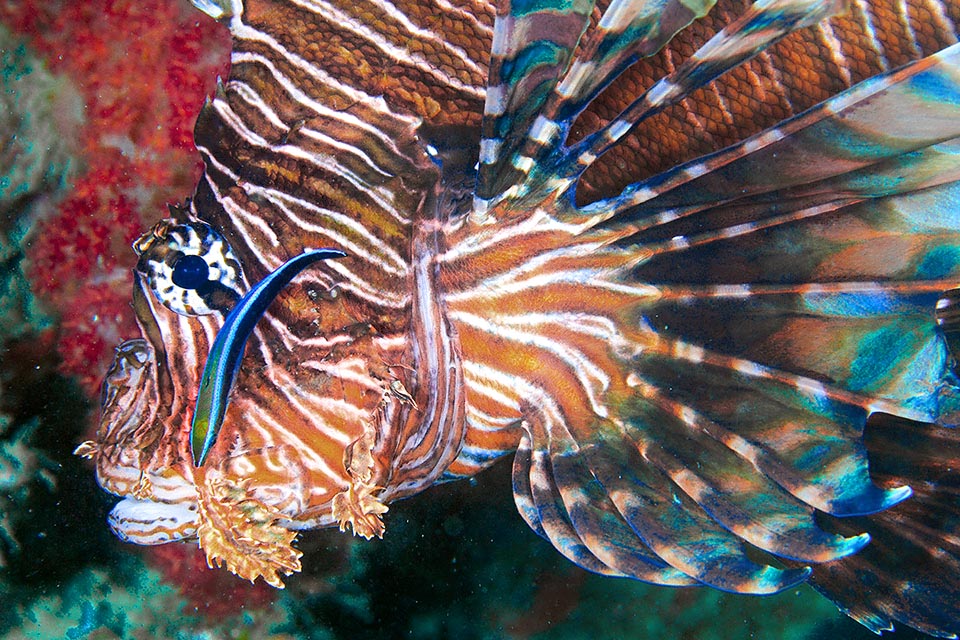
Here is with a cleaning labrid, but it will not find too much as, swimming little, Pterois volitans is protected by a thin cuticle that avoids the implant of weeds and parasites © Klaus Stiefel
Unfortunately, even if quite rarely, fatal accidents do occur.
The composition of the venom is little known. We only know that the toxin is thermolabile at 50-60 °C but perfectly resists freezing.
Ethology-Reproductive Biology
The adult Scorpionfish is a voracious nocturnal predator who devours about 50 species of various fishes, but also shrimps and crabs. With its big pectoral fins it pushes the prey in a corner and then aspires it suddenly with its huge protractile mouth holding it, when it does not go directly into the stomach, with its tiny teeth.
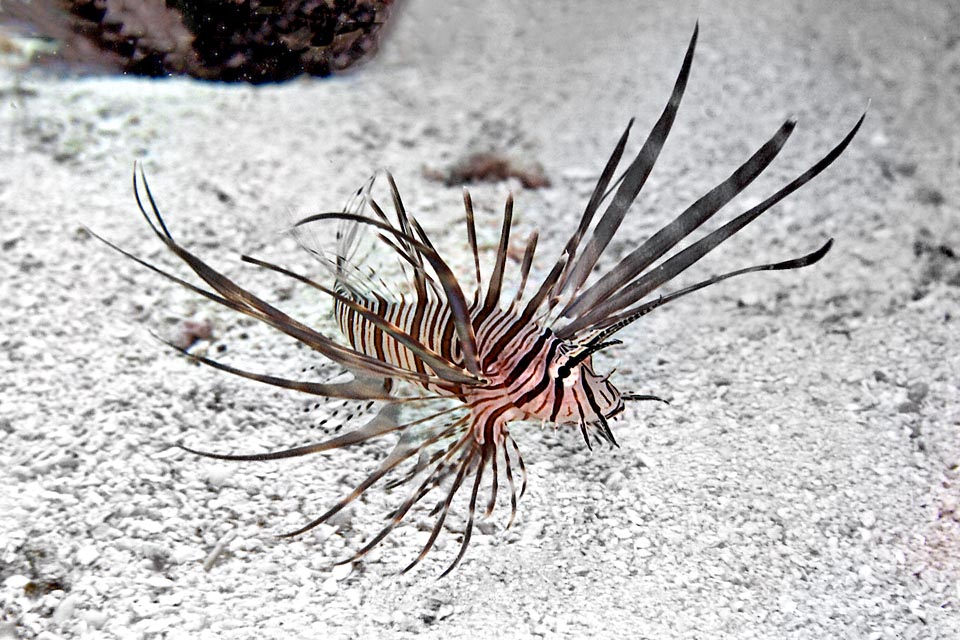
Juvenile. The females lay two million eggs per year and the larvae are carried by the currents for 20-35 days. In this way they spread the species over great distances before reaching the seabeds, often in mangroves formations or at mouth of rivers, where the kids grow up nourishing of numerous invertebrates such as worms and crustaceans © Allison & Carlos Estape
Conversely, the juveniles grow up nourishing of small invertebrates, mainly worms and crustaceans.
The males reach sexual maturity when they get the length of 10 cm, the females around the 18 cm, in order to be able to spawn about two million eggs per year.
In North Carolina it has been observed that the fecundation takes place on the surface, after a ritual courting. THe female released lumps every about 4 days with more than 24.000 eggs wrapped by a mucus. They measure about 800 microns and the larvae, carried by the currents for 20-35 days, once exhausted the yolk sac nourish of plankton.
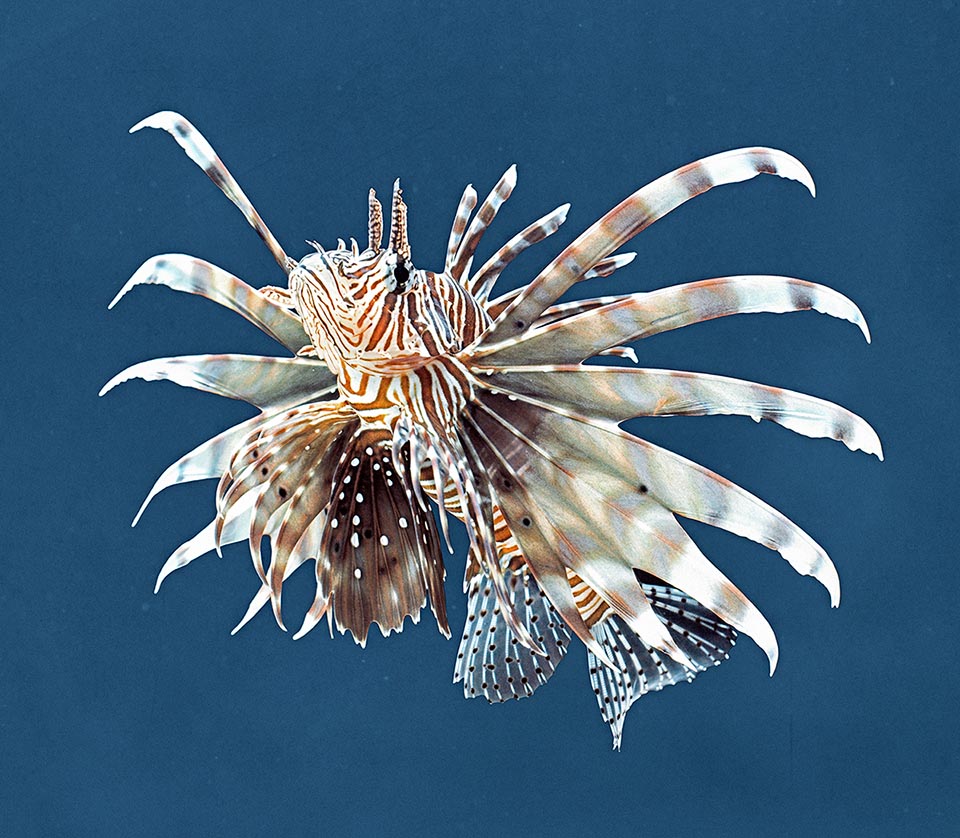
By sure Pterois volitans is not an endangered species. It incredibly adapts to various environments accepting also relatively low temperatures and the brackish water. It’s enough to have a surround of rocks and madrepores for trapping prey and a den where to sleep. Fished for aquaria long time in pools of adequate size © Giuseppe Mazza
The resilience is high with a possible doubling of the populations in less than 15 months and although widely fished due to the excellent quality of the flesh and presented as a delicacy in the local restaurants, the fishing vulnerability index is low and marks only 34 on a scale of 100.
The populations are increasing and in the Red List of the endangered species Pterois volitans appears as “Least Concern”.
Synonyms
Gasterosteus volitans Linnaeus, 1758.
→ For general information about FISH please click here.
→ For general information about BONY FISH please click here
→ For general information about CARTILAGINOUS FISH please click here.
→ To appreciate the BIODIVERSITY of BONY FISH please click here.
→ To appreciate the BIODIVERSITY of CARTILAGINOUS FISH please click here.
